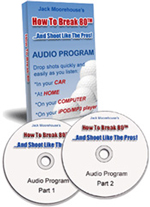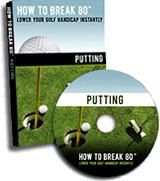
The Natural Swing: The Starting Form By Jack Moorhouse This is the second in a series of articles on the Natural Swing. The first article provided golf tips on the fundamental principles of the swing. In this article we look at the starting form for the swing, providing a brief golf lesson on the set up. Golf instruction sessions say that a flawless starting form offers the best opportunity of swinging properly. It sets the swing's tone, promotes feelings of simplicity, freedom, and balance, and ensures a positive result—if we get it right. If we don't get it right, we'll feel cramped and inhibited, and we'll probably hit a less than perfect shot, like a slice, a pull hook, or something worse. The set up in any golf swing is totally under our control—one of the few things in the game that is. The goal of the starting form of the natural swing is the same as any other golf swing. The starting form should set you up to make an aggressive move while remaining in balance. Ideally, it should be an athletic, graceful move, with purpose and direction. In the natural swing, the starting form focuses on things like target awareness, grip, stance, alignment, and ball location relative to the body. Target Awareness Grip The natural grip is not much different from your normal grip, except for the left hand. In the natural grip the club runs diagonally across the palms of your left hand (right-hand for left-handers). Position the last three fingers of the left hand around the club's butt end with your forefinger pushing against the thumb. This position generates a sensation of control and power in the left hand. The right hand fits over the left. The little finger fits in and over the index and forefinger of the left hand. The right-hand grip is mostly in the fingers. The correct grip pressure happens naturally when you assume the correct form. The relationship between the hands should not change during the swing.
The Stance In addition, you place the left foot slightly outside the left shoulder, so that you will be able to finish with your weight on your left foot. Balance is again the key. Most golfers roll toward the outside of the left foot when finishing the swing, which fosters a slight imbalance in the finish. But with the natural swing you move forward, so you want to finish flat on the left foot, with your weight evenly distributed across the whole foot. Alignment Ball position The difference between the starting form of the normal swing and that of the natural swing are subtle, but significant. In essence there are three key adjustments: (1) the placement of the left foot open, for balance and direction; (2) alignment to the target, which will be slightly different for everyone while remaining square to the target; (3) the constant position of the ball relative to the left foot. What's more, you need to evaluate your starting form each time you step up to the ball. The key to setting up properly with any swing, as I advocate in my golf lessons and golf tips, is to do it using the same routine time and time again. Do that and you'll be well on your way to lowering your golf handicap. Jack Moorehouse is the author of the best-selling book "How To Break 80 And Shoot Like The Pros." He is NOT a golf pro, rather a working man that has helped thousands of golfers from all seven continents lower their handicap immediately. He has a free weekly newsletter with the latest golf tips, golf lessons and golf instruction.
|
|





